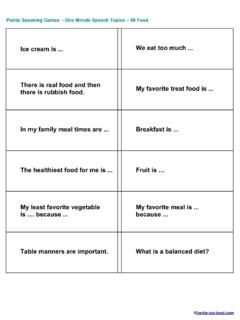Transcription of Food Security and Government Intervention
1 PUBLIC POLICY IN food AND AGRICULTURE - food Security and Government Intervention - Samarendu Mohanty, E. Wesley F. Peterson food Security AND Government Intervention . Samarendu Mohanty Assistant Professor, Department of Agricultural and Applied Economics, Texas Tech University, Lubbock, Texas, USA. E. Wesley F. Peterson Department of Agricultural and Applied Economics, University of Nebraska-Lincoln, USA. Keywords: food Security , interventions , Taxes, GATT, Tariffication, Market Access, Developing Countries, India, China, food Supply and Demand, Exchange Rate, Value Added, Simulation Models, Agricultural Trade, Specific-Factor Trade Models.
2 Contents S. TE S. R. AP LS. 1. Introduction 2. Forms of Government Intervention Price Policies C EO. Import and Export Policies 3. Agricultural Intervention and food Security 4. food Security and Macro Policy 5. Conclusion Bibliography E . H. Public Policies and Farming Business PL O. M SC. 1. Introduction All human societies must solve a set of problems related to food . The first of these is to procure edible plants and animals through some form of production process. Early SA NE. humans relied mainly on hunting, fishing, and gathering all of which are still practiced in the modern world.
3 About 10,000 years ago, certain plants and animals were domesticated giving rise to new methods to produce food . Crop production and animal U. husbandry generate the bulk of the food consumed in the world today. However, the products generated by farming and livestock systems around the world are of little use without resolution of a second set of problems related to the transformation of edible plants and animals into food and the distribution of this food across space and time. In traditional agricultural societies, most of the processing, storage and final food preparation is done by the farm household itself.
4 As modern systems of agriculture have developed, the transformation of raw commodities into food and the distribution of consumable food items throughout society increasingly take place beyond the farm gate. Modern food systems rely on complex production, transportation, processing, storage, marketing and distributional components to assure the supply and distribution of food and its associated nutritional elements. The performance of a national food system can be judged in relation to its effectiveness at generating adequate amounts of food that are distributed equitably among the entire Encyclopedia of Life Support Systems (EOLSS).
5 PUBLIC POLICY IN food AND AGRICULTURE - food Security and Government Intervention - Samarendu Mohanty, E. Wesley F. Peterson population. Other indicators of good performance include the nutritional health of the population, the sustainability of the food production and distribution systems, and the safety of the food supply. The concept of food Security covers all of these performance criteria. According to the food and Agriculture Organization (FAO), food Security means that all individuals have secure access to adequate safe and nutritious food to maintain a healthy life.
6 (FAO, 1996) This definition specifically recognizes the need for adequate amounts of food that is safe and nutritious and suggests that food Security would be compromised if access to food were limited to only a part of the population or if the food were produced in a way that is likely to lead to severe environmental degradation. An unsustainable food system would not guarantee secure access to food over time. The governments of virtually every country on the planet attach great importance to achieving food Security and a wide variety of mechanisms have been developed to realize this goal.
7 The first issue governments face in achieving national food Security is S. TE S. the problem of insuring that adequate amounts of food are available to the resident R. AP LS. population. Some governments have set goals of food self-sufficiency, which means most if not all of the food available in a country comes from the domestic farming system. However, food Security does not require food self-sufficiency because countries C EO. can import food items not easily produced within the country. Agricultural products are, after all, highly sensitive to climatic, topographic, soil and other conditions that tend to vary around the world.
8 Even countries with extremely productive agricultural sectors ( the United States, Canada, France, Australia, Brazil, etc.) are not fully self- sufficient in all food items. The United States, for example, depends on imports for its E . supply of coffee, tea, bananas and other tropical products. In general, the problem of H. assuring adequate food supplies is solved by relying on both domestic production and PL O. imports. M SC. It must be noted, however, that there can be constraints on a nation's ability to insure adequate food supplies from sources other than domestic production.
9 In order to purchase imported food , a nation has to export something to earn the foreign exchange SA NE. needed to pay for the imports. In most low-income countries, agriculture is still the primary economic activity and agricultural exports may be the main source of foreign exchange. It may seem paradoxical that a country could stand a better chance of U. achieving food Security by selling some of its domestic food production on the world market than by reserving all of its domestic production for home consumption. However, the paradox disappears when we remind ourselves that different kinds of food are produced in different countries.
10 A low-income country may be able to complement its domestic rice production with imports that are financed by exports of its surplus bananas. On the other hand, if a country is unable to earn enough foreign exchange through its exports, whether they are industrially transformed goods, commodities from the agricultural or mining sectors, services, or a combination of these items, it may not be able to import enough food to realize national food Security . The kinds of issues raised in the preceding paragraphs show why governments are intensely interested in both domestic agricultural production and trade.
















